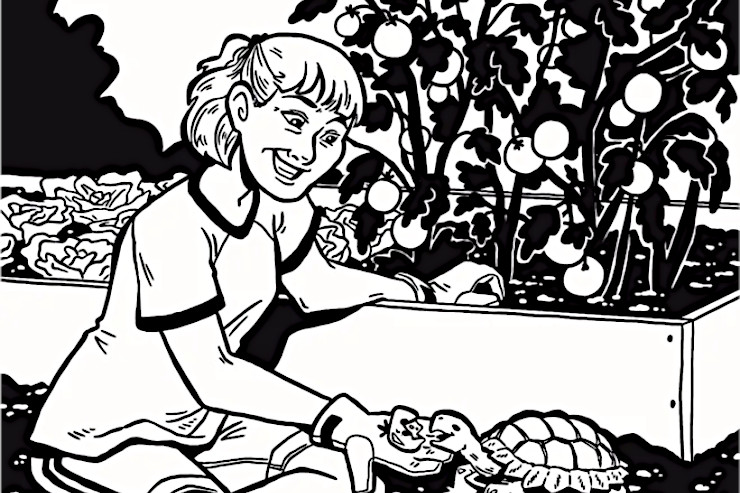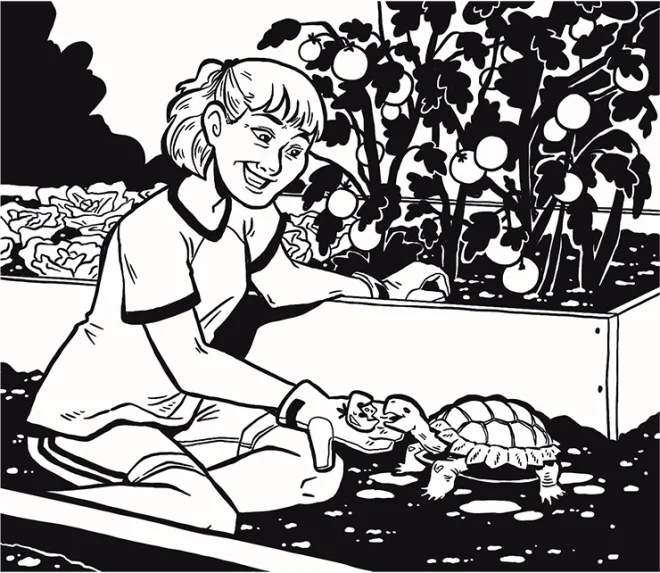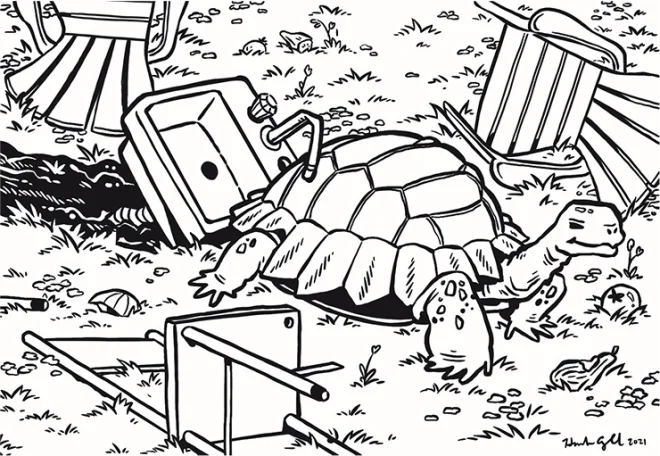
If you want to see some hilarious animal antics, take a walk through my garden. You’ll see squirrels chasing each other up and down the sunflowers, rabbits hopping around in the grass, and birds darting through the air. It’s always amusing to watch them interact with each other and with their surroundings. I’ve never had a tortoise in the garden though, like today’s author. That sounds like fun.
I have to admit that I sometimes feel like I’m living in a zoo! But it’s all good fun, and I love seeing the animals in my garden enjoying themselves. This year I finally got a bird bath and they’ve been loving it. It’s my daughter’s favorite thing to sit and watch, just a flock of tiny birds flapping about in the water.
Today’s story, “Sharing with Sheldon” is another story about animals in the garden. But Sheldon is a tortoise! In this story, you’ll hear the tale of a couple who decides to bring home a turtle who lives outside and enjoys the bounty of the garden, all the way up until he’s a whopping 70lbs. He contributes by eating scraps and making manure for the compost, but he’s also a bit handsy with the melons and lawn furniture as he gets bigger and grows older.
Keep reading for the rest of the story, which I’m sure you’ll enjoy as much as I did! If I lived in a warmer climate, I may have wanted a tortoise too!
Discover More Animals in the Garden
This story about a tortoise in the garden comes from our archive spanning over 30 years, and includes more than 130 magazine issues of GreenPrints. Pieces like these that turn stories about animals in the garden into everyday life lessons always brighten up my day, and I hope this story does for you as well. Enjoy!

Sharing with Sheldon
Is a pet tortoise a great companion—or a pain in the garden?
By Susan Barber

I will never forget the day that I came home from work to find my husband Kim puttering around with a new glass terrarium. A terrarium? Kim? What was going on? As I got closer, I saw a bumpy, olive-colored, egg-sized lump half buried in sawdust. It stirred, and a tiny head emerged.
An adorable baby tortoise hatchling had moved in with us. Sheldon was an African Spurred Tortoise no longer wanted by his former owner, one of Kim’s coworkers. We took him on a trial basis, but he wasn’t a trial at all—at least in the beginning. For a couple of years, Sheldon lived happily in his terrarium, eating canned tortoise food, lettuce, and other veggies, and basking in the sun that streamed in through the window. We enjoyed watching him lazily flip sawdust onto his shell and nibble on various tortoise delicacies. Visitors were entranced by our new pet. Time passed and Sheldon grew…and grew. We were so proud! Eventually, he became big enough that it was time to move him outside, into our mild San Diego County climate.
Kim meticulously crafted a high-tech, thermostatically controlled tortoise house for cooler nights. We added a swinging door made of a carpet remnant to keep the inside of the house toasty. We placed the house on a sunny corner of our back patio and filled it with bark chips so Sheldon could enjoy his natural tendency to bury himself. He was soon roaming our large backyard freely, eating grass and weeds. When apples fell from our apple trees and rolled under bushes, Sheldon found and feasted on them. Tomatoes with bird-beak damage? Sheldon could have them. He would hang around when I harvested snap peas or green beans, hoping for a handout. And we never had to worry about all the extra zucchini, as Sheldon gobbled it all. Hand-feeding Sheldon strawberries was a test of our reflexes, as he would extend his brontosaurus-like neck and snap his razor-sharp jaws. You had to move quick!
Although he didn’t demonstrate any actual affection towards us, Sheldon was entertaining to watch, and our fondness for him continued to grow. We had several scares when we couldn’t find him, but every time he was either fully buried in his bark chips or hidden behind a shrub or bush. We were always relieved when we finally discovered him safe and sound and eager to snatch a slice of watermelon from our carefully extended fingers.
Most of my garden was in raised beds or half barrels, and in these early years Sheldon satisfied himself with whatever we fed him or was growing at ground level. And feed him we did: he was a vacuum cleaner with an insatiable appetite. I discovered several types of weeds that Sheldon loved, so when I found these in my barrels or raised beds I would feed them to him. This added a new, quite pleasant dimension to weeding. In addition, Sheldon made lots and lots of great manure. Imagine the elephant pen at the zoo, on a slightly smaller scale. Sheldon’s manure was compact, mostly odorless, easy to pick up, and it contributed to the best compost I have ever had. We had developed a stable, mutually beneficial relationship with our resident reptile.
But Sheldon continued to grow—and things began to happen. Apparently I had failed to recognize how large Sheldon had become. It’s like watching your children grow: they change so incrementally that you’re surprised they’ve become huge, hulking teenagers!
One day I went to check on a beautiful cantaloupe that was hanging over the rim of an oak whiskey barrel. I had long waited for the day it would ripen and I could relish its delectable sweetness. However, unnoticed by me, Sheldon had grown big and strong enough to crawl halfway up the side of the barrel and reach my melon. All I found on the planned harvest day was a ragged scrap of cantaloupe skin and a monster tortoise with dribbles running down his neck. Kim tried to calm me: “It’s just one cantaloupe. Sheldon doesn’t understand!”
I did a thorough inspection of the rest of the garden, trying to view it through tortoise eyes, and then rearranged pots and barrels as needed to protect my crops.
But Sheldon wasn’t so easily deterred. He had tasted the for-bidden fruits and wanted more. Somehow he managed to knock an entire tomato pot over—and then feasted on the heirloom tomatoes I had carefully nurtured from seed. Kim, my ever-patient husband, again tried to calm me down: he must have seen the pot of turtle soup simmering in my mind’s eye.
When I could again think clearly, I realized Sheldon’s inscrutable appearance was hiding a fierce determination to get what he wanted. He had all the time in the world to reach his objective and would not give up until he succeeded. And I had contributed to his lust for my produce by introducing him to tomato leftovers and melon scraps! I had lost this battle. But I was not yet ready to concede the war.

I built barricades out of concrete blocks and increased the height of the raised beds. To keep Sheldon satiated, I gave him enormous salads made from his favorite garden delicacies and continued to share my extra crops with him. He feasted on cucumbers, radish tops, beet greens, and more. He could now climb over the edging and reach the berry patch. We were happy to share the low-hanging blackberries, boysenberries, and loganberries with him, as we always had more than enough to make gallons of jam. Vendors at the farmers market were glad to give me their trimmings and bruised fruit “for my tortoise.” I was on top of this! Sheldon did his part to contribute by producing increasing mountains of manure and chomping on the lawn.
Our détente lasted another few years. I imagined the three of us growing old together, sharing strawberries in the sunshine.
But by now Sheldon was 18 inches long and about 8 inches high and weighed close to 70 pounds. A four-legged steamroller, he inched along no matter what was in his path. His constant crossing back and forth sent him underneath tables, chairs, the barbecue, our portable fire pit, and whatever else was outside. He was too stubborn to back out, so whatever got stuck on his shell went wherever he went. Kim good-naturedly took on the role of outdoor furniture relocation expert. I, however, was beginning to question how long this could last.
The straw that broke these tortoise owners’ backs came shortly after a burst pipe in our house led to some kitchen remodeling. Our old porcelain double sink ended up sitting by the trash cans, awaiting proper disposal. It weighed well over 100 pounds. We came home one afternoon and found it had been moved about 75 yards, from the side of the house to the middle of our back lawn, and there were long gouges in the concrete pathway and a huge gorge in the grass. It took both of us to move the sink back to a safe place, with Sheldon completely unaware of the havoc that he had caused. It took months for the grass to fill back in.
We made the tough decision. After a short search, we found a more appropriate home for Sheldon in a rural area. The new owner had several other African spurred tortoises, a huge open fenced yard, and no garden or patio furniture to damage. Shel-don had clearly outgrown our property, and this new place was perfect for him.
I think of Sheldon whenever I remove the tops from carrots, harvest snap peas, or cut into a juicy melon. When the apples fall on the ground, I miss watching Sheldon make a beeline (well, tortoiseline) to the treasure. When I harvest my homemade compost or pick up a load from the city yard, I always compare the quality and richness to the compost I had when Sheldon’s manure augmented it. (Doesn’t come close.)
But when I get nostalgic for Sheldon, I picture him happily wandering in his new home, burrowing with his tortoise friends in his spacious yard, devouring mountains of fresh fruits and veggies without any obstacles in his way, enjoying a peaceful old age.
And Kim and I, enjoying ours. ❖
By Susan Barber, published originally in 2021-2022, in GreenPrints Issue #128. Illustrated by Hannah England

Do you have a tortoise in the garden? I love the idea of a living composter (ha!). Leave a comment below, I’d love to hear it!



